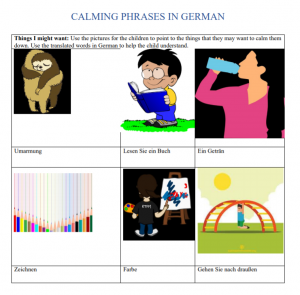32 Calming phrases in German
Stefanie Kennedy
Rationale
Often children will come into a care setting from a different linguistic background to the educators. This can be upsetting and stressful to not only the child but the educators as well. This resource is a quick reference guide for educators with key phrases and activities to possibly use to settle a distressed child. The chosen language for the guide is German, however it could be created to suit the cultural/linguistic background of each individual child. The resource can be utilised in various ways, the pictures allow the children to choose an activity that may assist them in calming down without needing to verbalise. The words under the pictures are in German if the child does want to verbalise, the educator has the opportunity to understand. At the bottom of the page there are some key phrases designed for educators to use to reassure the child that they are safe, and Mum and Dad are coming back.
The governing bodies for the early years require that educators respect, value and include every child. The above resource assists in this and aligns with the Early Years Learning Framework: Learning Outcome 5.1 Children interact verbally and non-verbally with others for a range of purposes (Department of Education, Employment and Workplace Relations (DEEWR), 2009). To accomplish learning outcome 5.1 educators are required to be ‘attuned and respond sensitively and appropriately to children’s efforts to communicate’ (DEEWR, 2009, p. 40.) The resource allows children to communicate needs/wants with educators while overcoming the language barrier. The Queensland Kindergarten Learning Guidelines state that when educators respect, value and celebrate diversity, they actively explore, build and strengthen their own and others’ cultural competence (QCAA, 2018b.) By being inclusive and learning key phrases in a different language assists educators to embrace linguistic and cultural diversity. The National Quality Standard: Quality Area 2 states, ‘All children have the right to experience quality education and care in an environment that provides for their physical and psychological wellbeing and provides support for each child’s growing competence, confidence and independence’ (ACECQA, 2020b).


